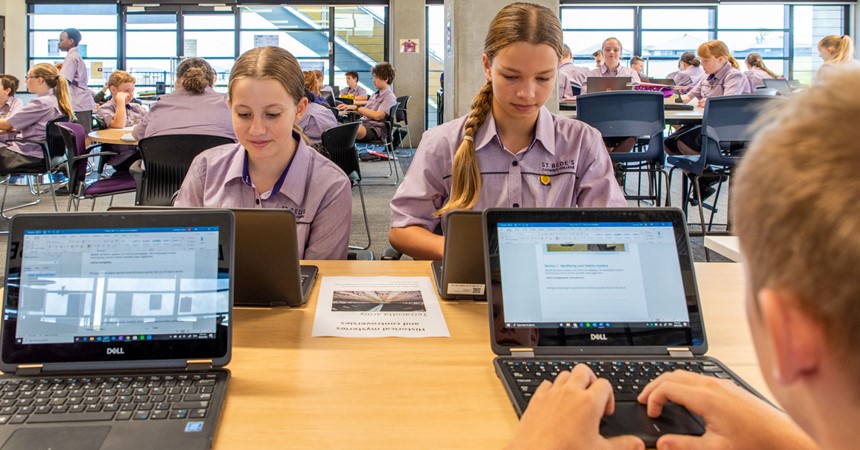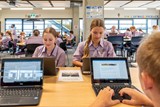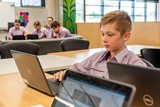As with most schools, St Bede’s Catholic College, Chisholm has changed rapidly in the COVID-19 pandemic. But this was a smooth transition for St Bede’s, largely thanks to the work of the school’s leadership team including principal John Murphy, and assistant principal Brett Donohoe, as well as its strong ICT team including ICT support officer Ray Burg, and learning technology co-ordinator Andrew Cornwall.
Located between Maitland and Newcastle, St Bede’s is a Catholic systemic school that opened in 2018. It currently caters for 360 students in Years 7-9 and a rapidly growing community in the expanding Chisholm and Maitland region. The school is expected to grow by about 180 students per year, with the first Year 12 cohort graduating in 2023.
St Bede’s differs from many other secondary schools thanks to its bring your own specified device (BYOSD) program. The school investigated and selected a single device for student learning from a single supplier. The resulting program ensures all students are equipped with a robust education-specific two-in-one device.
The key advantages of this kind of program include a reliable and standardised device for all students, equity for learning, and ease of assistance for the school’s ICT support officer. The program came into its own after the coronavirus hit.
“In placing a high priority on digital literacy and with a specified bring your own device platform, the transition to fully remote on-line learning proceeded remarkably smoothly,” said Mr Murphy. “Strong student attendance and engagement data and positive feedback from staff, students and parents verified the success of transitioning to a fully remote learning program in a matter of days.”
During remote learning, teachers could rely on students having a consistent experience that included camera, microphone, stylus, keyboard, and mouse. Remote diagnosis and student support were easy.
St Bede’s piloted Microsoft Teams in 2018 and has coupled it with other technologies such as Maths Pathways, ClickView, and Quizlet to develop a uniform and cohesive digital learning environment.
During the period of remote learning, Microsoft Teams was core to St Bede’s success. Microsoft Teams meetings helped teachers and students stay engaged using video, and integration with Microsoft Stream enabled easy recording. The communication tools kept students and staff connected and engaged with their learning and minimised internal email. The Assignment tool was an effective way of distributing work to students, collecting, and providing feedback.
“Most classwork was done through Microsoft Teams Assignment,” said Year 9 student Xander. “This allowed the teachers to see which students had viewed, started and submitted the classwork. Although this learning was not preferable over normal learning in a classroom, it was all about making the best out of a bad situation, and the staff at St Bede’s certainly did that.”
While there is much debate in adult learning about “just-in-case” and “just-in-time”, St Bede’s has balanced the two when it comes to technology. With a new cohort of staff and students each year, the school has coupled a thorough orientation program including training and development with the support of ongoing coaching.
During a three-phase orientation program, students learn about their device and the tools and technologies used at the school, first though whole-group induction, followed by a progressive release of responsibility. Similarly, staff are given an early induction program and then mentored during their first term. There is also regular technology coaching from the learning technology team and their student leaders.
Keeping the devices and software standardised has assisted in streamlining this process, with students and staff needing to only familiarise themselves with one device and one digital learning environment.
This strong focus on getting staff and students up to speed has been effective in the COVID crisis. Even though a third of staff and students were new in 2020, by the time the remote learning program began late in Term 1, almost all of them felt comfortable with the new tools and technologies and it was a relatively easy transition into online.
Mr Donohoe said St Bede’s has placed a high priority on the use of technology to support innovative and contemporary learning. “To maintain this as a key focus in our pedagogical approach it has been imperative we provide continual professional development opportunities for our existing staff,” he said. “Equally important, we must ensure all new staff to St Bede’s are upskilled, so they are confident and competent in the use of all technological platforms such as Microsoft Teams, OneNote, Office 365 and Compass. The college was able to leverage this program to build upon the existing technological skills of our staff before the implementation of the remote learning program.”
The success of St Bede’s during the remote learning period was largely due to the college’s planning and preparation. Effective leadership in teaching and learning with technology, investing in reliable hardware and software, and ensuring consistent and well-delivered training for staff and students were the cornerstone of the school’s approach.
Mr Cornwall is proud of the college’s technology proficiency. “For St Bede’s Catholic College, Chisholm, technology is no longer something we do; it is the way we do something,” he said.
To find out more about St Bede's, Chisholm or to enrol your child, please click here.




